Cloud Computing: Analysis of Advantages and Disadvantages in Business
VerifiedAdded on 2020/03/07
|13
|3677
|190
Report
AI Summary
This report provides a comprehensive analysis of cloud computing, focusing on its advantages and disadvantages for businesses. It begins with an introduction to cloud computing, defining its origin and evolution, and outlining the project's objectives and scope. The literature review explores various aspects, including service and deployment models (SaaS, PaaS, IaaS, Private, Public, Community, and Hybrid), and a critical analysis of its strengths, such as reduced IT management, efficient data handling, and increased developer productivity. The report also addresses security concerns and other disadvantages, offering recommendations for improving cloud infrastructure. The conceptual framework illustrates the relationships between cloud service providers, clients, service models, and deployment models. The report emphasizes the importance of data security and privacy, making it a valuable resource for understanding cloud computing's impact on modern business operations. Finally, the report also includes figures to describe the deployment of cloud computing for making business better and convenient for both supplier and user.
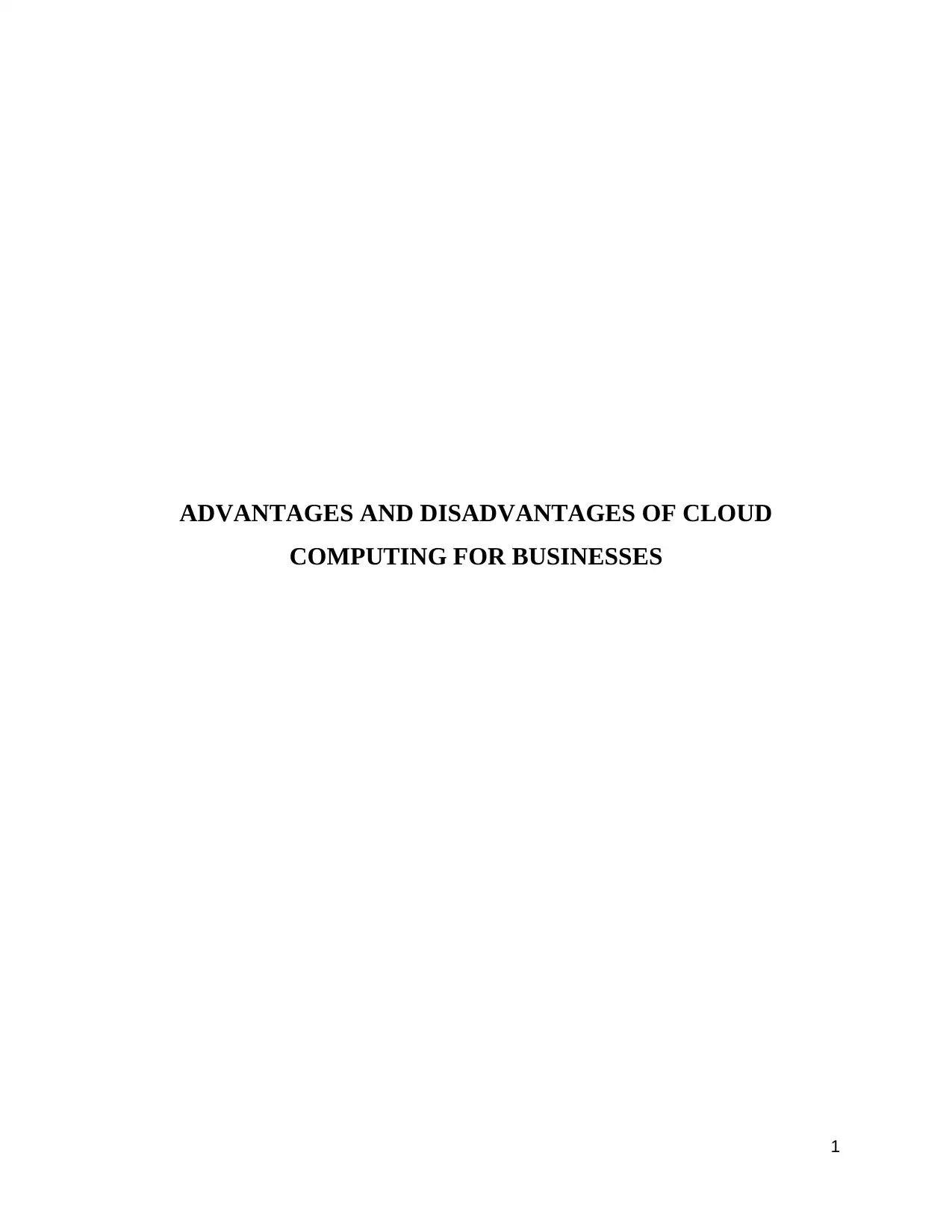
ADVANTAGES AND DISADVANTAGES OF CLOUD
COMPUTING FOR BUSINESSES
1
COMPUTING FOR BUSINESSES
1
Paraphrase This Document
Need a fresh take? Get an instant paraphrase of this document with our AI Paraphraser
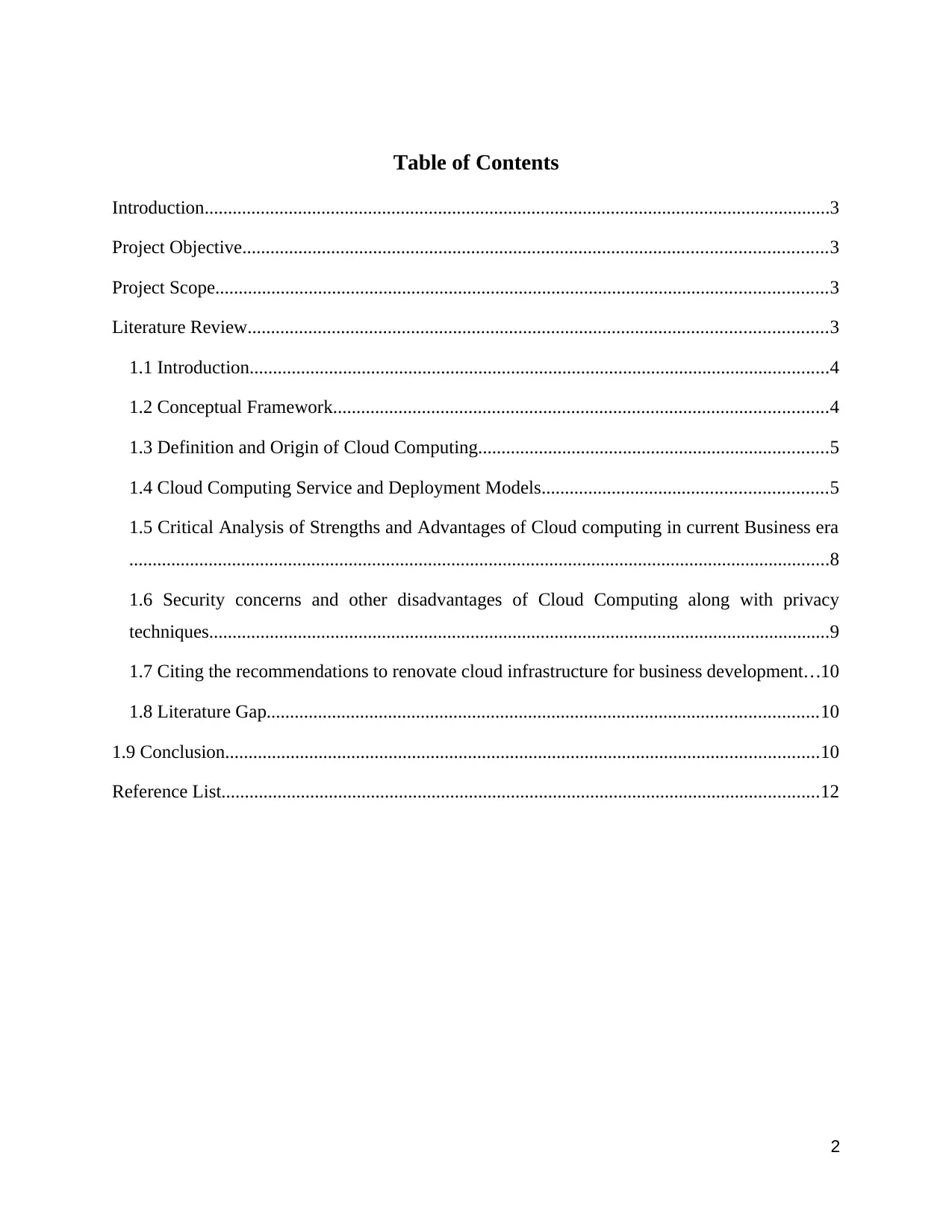
Table of Contents
Introduction......................................................................................................................................3
Project Objective.............................................................................................................................3
Project Scope...................................................................................................................................3
Literature Review............................................................................................................................3
1.1 Introduction............................................................................................................................4
1.2 Conceptual Framework..........................................................................................................4
1.3 Definition and Origin of Cloud Computing...........................................................................5
1.4 Cloud Computing Service and Deployment Models.............................................................5
1.5 Critical Analysis of Strengths and Advantages of Cloud computing in current Business era
......................................................................................................................................................8
1.6 Security concerns and other disadvantages of Cloud Computing along with privacy
techniques.....................................................................................................................................9
1.7 Citing the recommendations to renovate cloud infrastructure for business development...10
1.8 Literature Gap......................................................................................................................10
1.9 Conclusion...............................................................................................................................10
Reference List................................................................................................................................12
2
Introduction......................................................................................................................................3
Project Objective.............................................................................................................................3
Project Scope...................................................................................................................................3
Literature Review............................................................................................................................3
1.1 Introduction............................................................................................................................4
1.2 Conceptual Framework..........................................................................................................4
1.3 Definition and Origin of Cloud Computing...........................................................................5
1.4 Cloud Computing Service and Deployment Models.............................................................5
1.5 Critical Analysis of Strengths and Advantages of Cloud computing in current Business era
......................................................................................................................................................8
1.6 Security concerns and other disadvantages of Cloud Computing along with privacy
techniques.....................................................................................................................................9
1.7 Citing the recommendations to renovate cloud infrastructure for business development...10
1.8 Literature Gap......................................................................................................................10
1.9 Conclusion...............................................................................................................................10
Reference List................................................................................................................................12
2
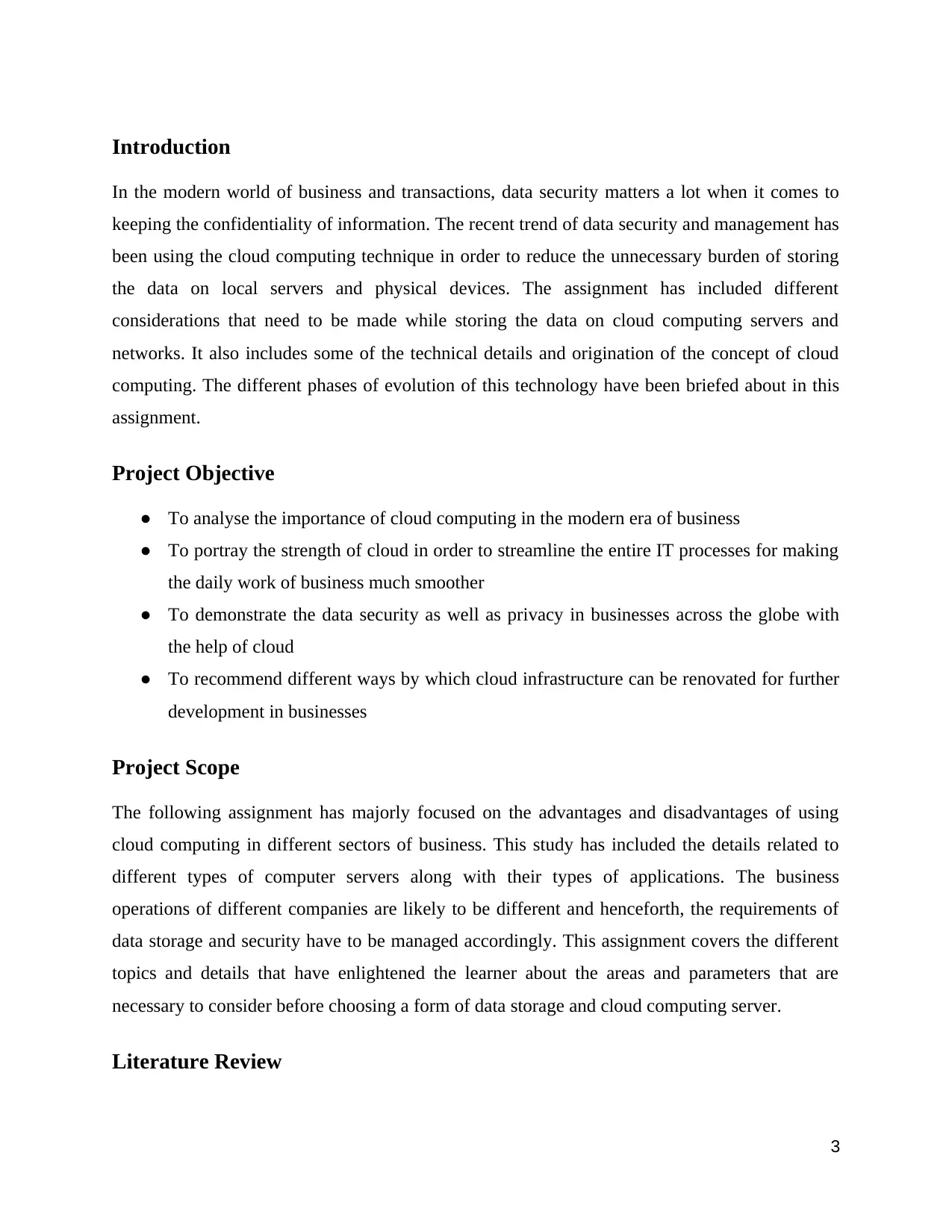
Introduction
In the modern world of business and transactions, data security matters a lot when it comes to
keeping the confidentiality of information. The recent trend of data security and management has
been using the cloud computing technique in order to reduce the unnecessary burden of storing
the data on local servers and physical devices. The assignment has included different
considerations that need to be made while storing the data on cloud computing servers and
networks. It also includes some of the technical details and origination of the concept of cloud
computing. The different phases of evolution of this technology have been briefed about in this
assignment.
Project Objective
● To analyse the importance of cloud computing in the modern era of business
● To portray the strength of cloud in order to streamline the entire IT processes for making
the daily work of business much smoother
● To demonstrate the data security as well as privacy in businesses across the globe with
the help of cloud
● To recommend different ways by which cloud infrastructure can be renovated for further
development in businesses
Project Scope
The following assignment has majorly focused on the advantages and disadvantages of using
cloud computing in different sectors of business. This study has included the details related to
different types of computer servers along with their types of applications. The business
operations of different companies are likely to be different and henceforth, the requirements of
data storage and security have to be managed accordingly. This assignment covers the different
topics and details that have enlightened the learner about the areas and parameters that are
necessary to consider before choosing a form of data storage and cloud computing server.
Literature Review
3
In the modern world of business and transactions, data security matters a lot when it comes to
keeping the confidentiality of information. The recent trend of data security and management has
been using the cloud computing technique in order to reduce the unnecessary burden of storing
the data on local servers and physical devices. The assignment has included different
considerations that need to be made while storing the data on cloud computing servers and
networks. It also includes some of the technical details and origination of the concept of cloud
computing. The different phases of evolution of this technology have been briefed about in this
assignment.
Project Objective
● To analyse the importance of cloud computing in the modern era of business
● To portray the strength of cloud in order to streamline the entire IT processes for making
the daily work of business much smoother
● To demonstrate the data security as well as privacy in businesses across the globe with
the help of cloud
● To recommend different ways by which cloud infrastructure can be renovated for further
development in businesses
Project Scope
The following assignment has majorly focused on the advantages and disadvantages of using
cloud computing in different sectors of business. This study has included the details related to
different types of computer servers along with their types of applications. The business
operations of different companies are likely to be different and henceforth, the requirements of
data storage and security have to be managed accordingly. This assignment covers the different
topics and details that have enlightened the learner about the areas and parameters that are
necessary to consider before choosing a form of data storage and cloud computing server.
Literature Review
3
⊘ This is a preview!⊘
Do you want full access?
Subscribe today to unlock all pages.

Trusted by 1+ million students worldwide
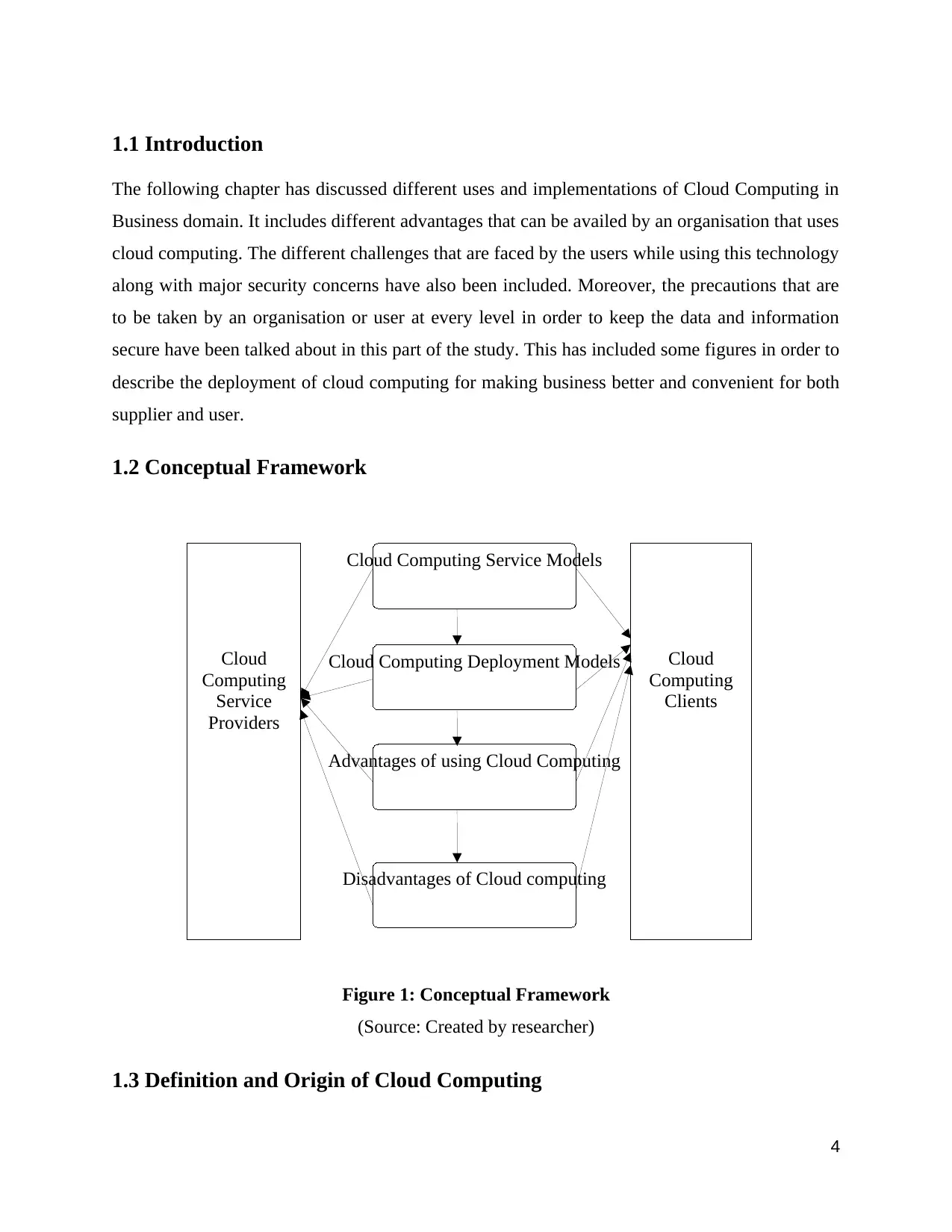
Cloud
Computing
Service
Providers
Cloud
Computing
Clients
Cloud Computing Service Models
Cloud Computing Deployment Models
Advantages of using Cloud Computing
Disadvantages of Cloud computing
1.1 Introduction
The following chapter has discussed different uses and implementations of Cloud Computing in
Business domain. It includes different advantages that can be availed by an organisation that uses
cloud computing. The different challenges that are faced by the users while using this technology
along with major security concerns have also been included. Moreover, the precautions that are
to be taken by an organisation or user at every level in order to keep the data and information
secure have been talked about in this part of the study. This has included some figures in order to
describe the deployment of cloud computing for making business better and convenient for both
supplier and user.
1.2 Conceptual Framework
Figure 1: Conceptual Framework
(Source: Created by researcher)
1.3 Definition and Origin of Cloud Computing
4
Computing
Service
Providers
Cloud
Computing
Clients
Cloud Computing Service Models
Cloud Computing Deployment Models
Advantages of using Cloud Computing
Disadvantages of Cloud computing
1.1 Introduction
The following chapter has discussed different uses and implementations of Cloud Computing in
Business domain. It includes different advantages that can be availed by an organisation that uses
cloud computing. The different challenges that are faced by the users while using this technology
along with major security concerns have also been included. Moreover, the precautions that are
to be taken by an organisation or user at every level in order to keep the data and information
secure have been talked about in this part of the study. This has included some figures in order to
describe the deployment of cloud computing for making business better and convenient for both
supplier and user.
1.2 Conceptual Framework
Figure 1: Conceptual Framework
(Source: Created by researcher)
1.3 Definition and Origin of Cloud Computing
4
Paraphrase This Document
Need a fresh take? Get an instant paraphrase of this document with our AI Paraphraser
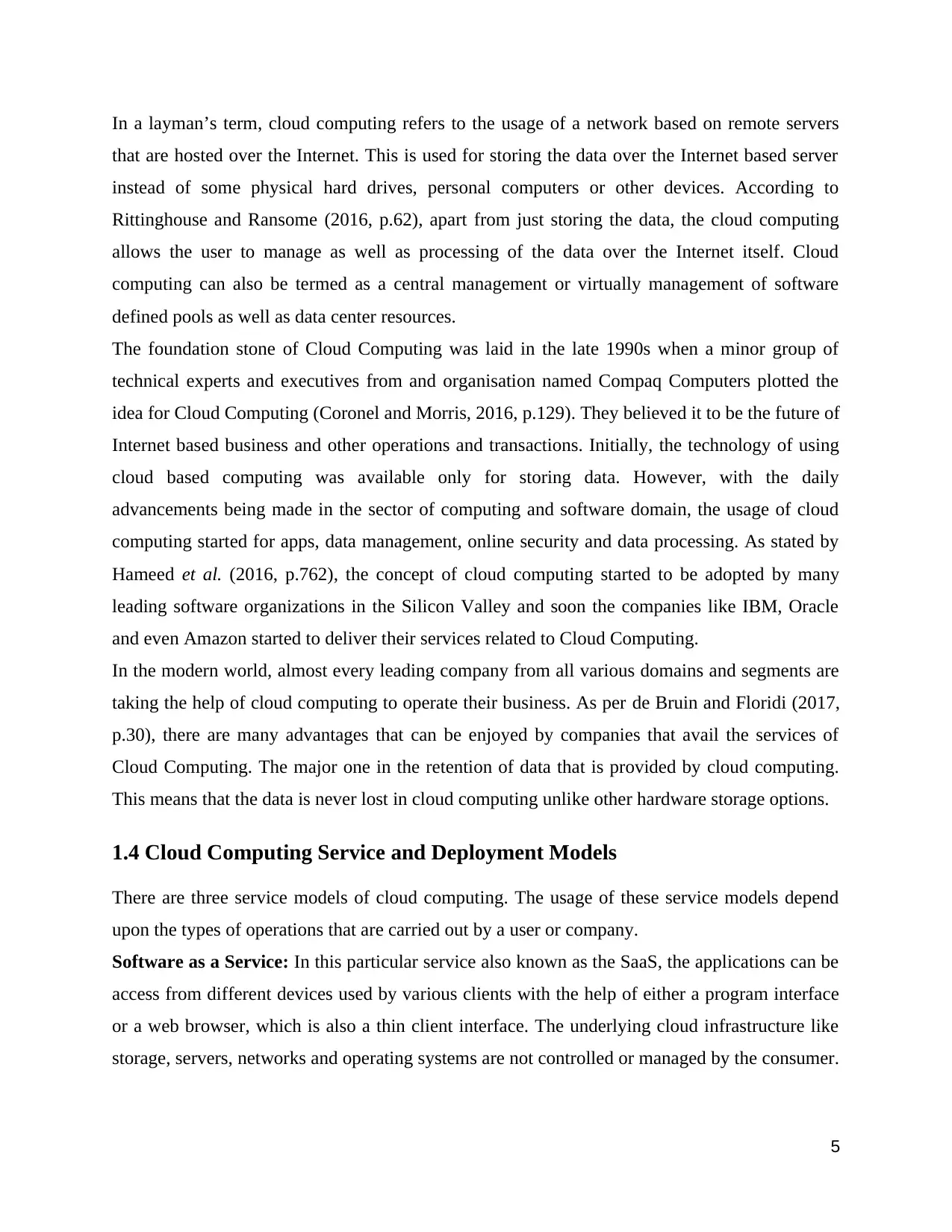
In a layman’s term, cloud computing refers to the usage of a network based on remote servers
that are hosted over the Internet. This is used for storing the data over the Internet based server
instead of some physical hard drives, personal computers or other devices. According to
Rittinghouse and Ransome (2016, p.62), apart from just storing the data, the cloud computing
allows the user to manage as well as processing of the data over the Internet itself. Cloud
computing can also be termed as a central management or virtually management of software
defined pools as well as data center resources.
The foundation stone of Cloud Computing was laid in the late 1990s when a minor group of
technical experts and executives from and organisation named Compaq Computers plotted the
idea for Cloud Computing (Coronel and Morris, 2016, p.129). They believed it to be the future of
Internet based business and other operations and transactions. Initially, the technology of using
cloud based computing was available only for storing data. However, with the daily
advancements being made in the sector of computing and software domain, the usage of cloud
computing started for apps, data management, online security and data processing. As stated by
Hameed et al. (2016, p.762), the concept of cloud computing started to be adopted by many
leading software organizations in the Silicon Valley and soon the companies like IBM, Oracle
and even Amazon started to deliver their services related to Cloud Computing.
In the modern world, almost every leading company from all various domains and segments are
taking the help of cloud computing to operate their business. As per de Bruin and Floridi (2017,
p.30), there are many advantages that can be enjoyed by companies that avail the services of
Cloud Computing. The major one in the retention of data that is provided by cloud computing.
This means that the data is never lost in cloud computing unlike other hardware storage options.
1.4 Cloud Computing Service and Deployment Models
There are three service models of cloud computing. The usage of these service models depend
upon the types of operations that are carried out by a user or company.
Software as a Service: In this particular service also known as the SaaS, the applications can be
access from different devices used by various clients with the help of either a program interface
or a web browser, which is also a thin client interface. The underlying cloud infrastructure like
storage, servers, networks and operating systems are not controlled or managed by the consumer.
5
that are hosted over the Internet. This is used for storing the data over the Internet based server
instead of some physical hard drives, personal computers or other devices. According to
Rittinghouse and Ransome (2016, p.62), apart from just storing the data, the cloud computing
allows the user to manage as well as processing of the data over the Internet itself. Cloud
computing can also be termed as a central management or virtually management of software
defined pools as well as data center resources.
The foundation stone of Cloud Computing was laid in the late 1990s when a minor group of
technical experts and executives from and organisation named Compaq Computers plotted the
idea for Cloud Computing (Coronel and Morris, 2016, p.129). They believed it to be the future of
Internet based business and other operations and transactions. Initially, the technology of using
cloud based computing was available only for storing data. However, with the daily
advancements being made in the sector of computing and software domain, the usage of cloud
computing started for apps, data management, online security and data processing. As stated by
Hameed et al. (2016, p.762), the concept of cloud computing started to be adopted by many
leading software organizations in the Silicon Valley and soon the companies like IBM, Oracle
and even Amazon started to deliver their services related to Cloud Computing.
In the modern world, almost every leading company from all various domains and segments are
taking the help of cloud computing to operate their business. As per de Bruin and Floridi (2017,
p.30), there are many advantages that can be enjoyed by companies that avail the services of
Cloud Computing. The major one in the retention of data that is provided by cloud computing.
This means that the data is never lost in cloud computing unlike other hardware storage options.
1.4 Cloud Computing Service and Deployment Models
There are three service models of cloud computing. The usage of these service models depend
upon the types of operations that are carried out by a user or company.
Software as a Service: In this particular service also known as the SaaS, the applications can be
access from different devices used by various clients with the help of either a program interface
or a web browser, which is also a thin client interface. The underlying cloud infrastructure like
storage, servers, networks and operating systems are not controlled or managed by the consumer.
5
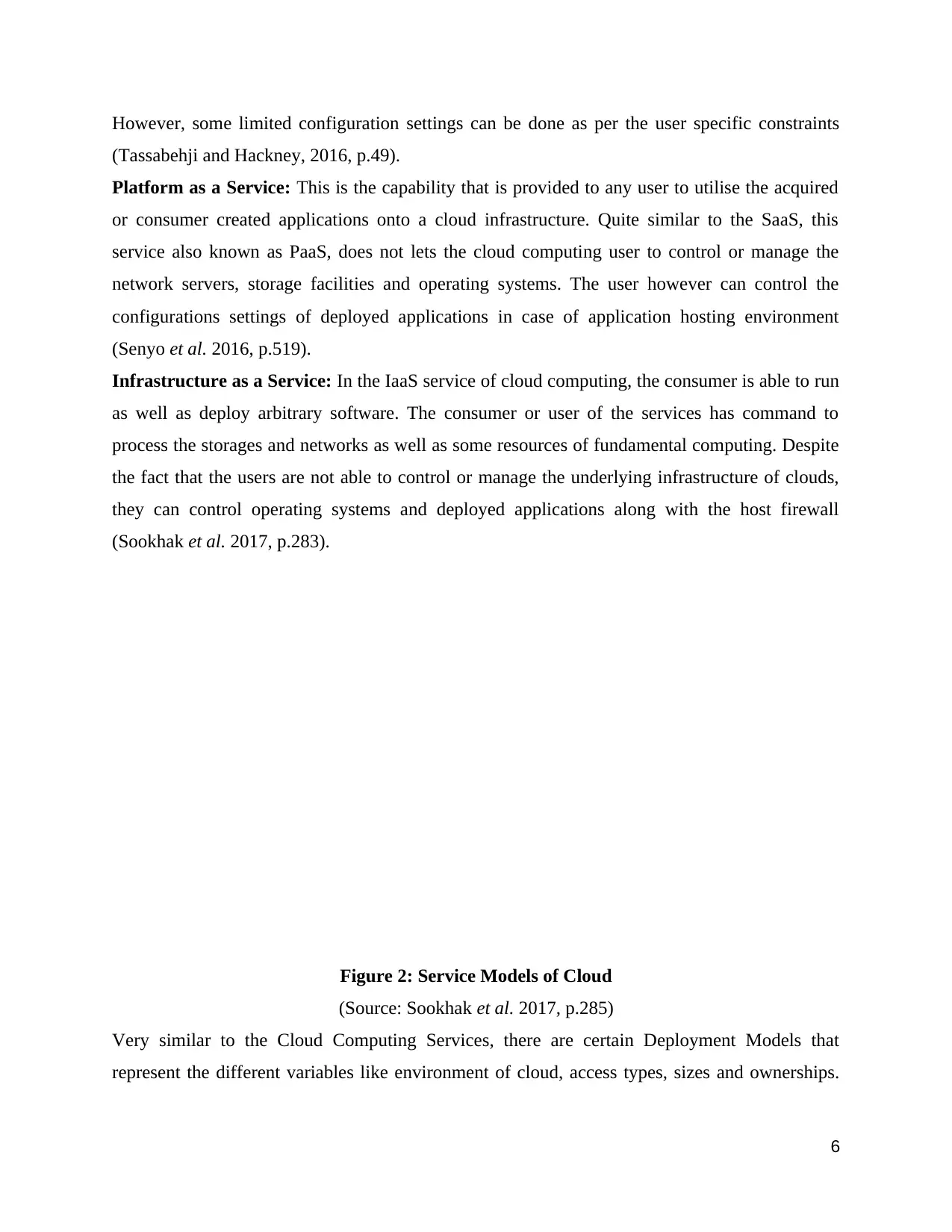
However, some limited configuration settings can be done as per the user specific constraints
(Tassabehji and Hackney, 2016, p.49).
Platform as a Service: This is the capability that is provided to any user to utilise the acquired
or consumer created applications onto a cloud infrastructure. Quite similar to the SaaS, this
service also known as PaaS, does not lets the cloud computing user to control or manage the
network servers, storage facilities and operating systems. The user however can control the
configurations settings of deployed applications in case of application hosting environment
(Senyo et al. 2016, p.519).
Infrastructure as a Service: In the IaaS service of cloud computing, the consumer is able to run
as well as deploy arbitrary software. The consumer or user of the services has command to
process the storages and networks as well as some resources of fundamental computing. Despite
the fact that the users are not able to control or manage the underlying infrastructure of clouds,
they can control operating systems and deployed applications along with the host firewall
(Sookhak et al. 2017, p.283).
Figure 2: Service Models of Cloud
(Source: Sookhak et al. 2017, p.285)
Very similar to the Cloud Computing Services, there are certain Deployment Models that
represent the different variables like environment of cloud, access types, sizes and ownerships.
6
(Tassabehji and Hackney, 2016, p.49).
Platform as a Service: This is the capability that is provided to any user to utilise the acquired
or consumer created applications onto a cloud infrastructure. Quite similar to the SaaS, this
service also known as PaaS, does not lets the cloud computing user to control or manage the
network servers, storage facilities and operating systems. The user however can control the
configurations settings of deployed applications in case of application hosting environment
(Senyo et al. 2016, p.519).
Infrastructure as a Service: In the IaaS service of cloud computing, the consumer is able to run
as well as deploy arbitrary software. The consumer or user of the services has command to
process the storages and networks as well as some resources of fundamental computing. Despite
the fact that the users are not able to control or manage the underlying infrastructure of clouds,
they can control operating systems and deployed applications along with the host firewall
(Sookhak et al. 2017, p.283).
Figure 2: Service Models of Cloud
(Source: Sookhak et al. 2017, p.285)
Very similar to the Cloud Computing Services, there are certain Deployment Models that
represent the different variables like environment of cloud, access types, sizes and ownerships.
6
⊘ This is a preview!⊘
Do you want full access?
Subscribe today to unlock all pages.

Trusted by 1+ million students worldwide
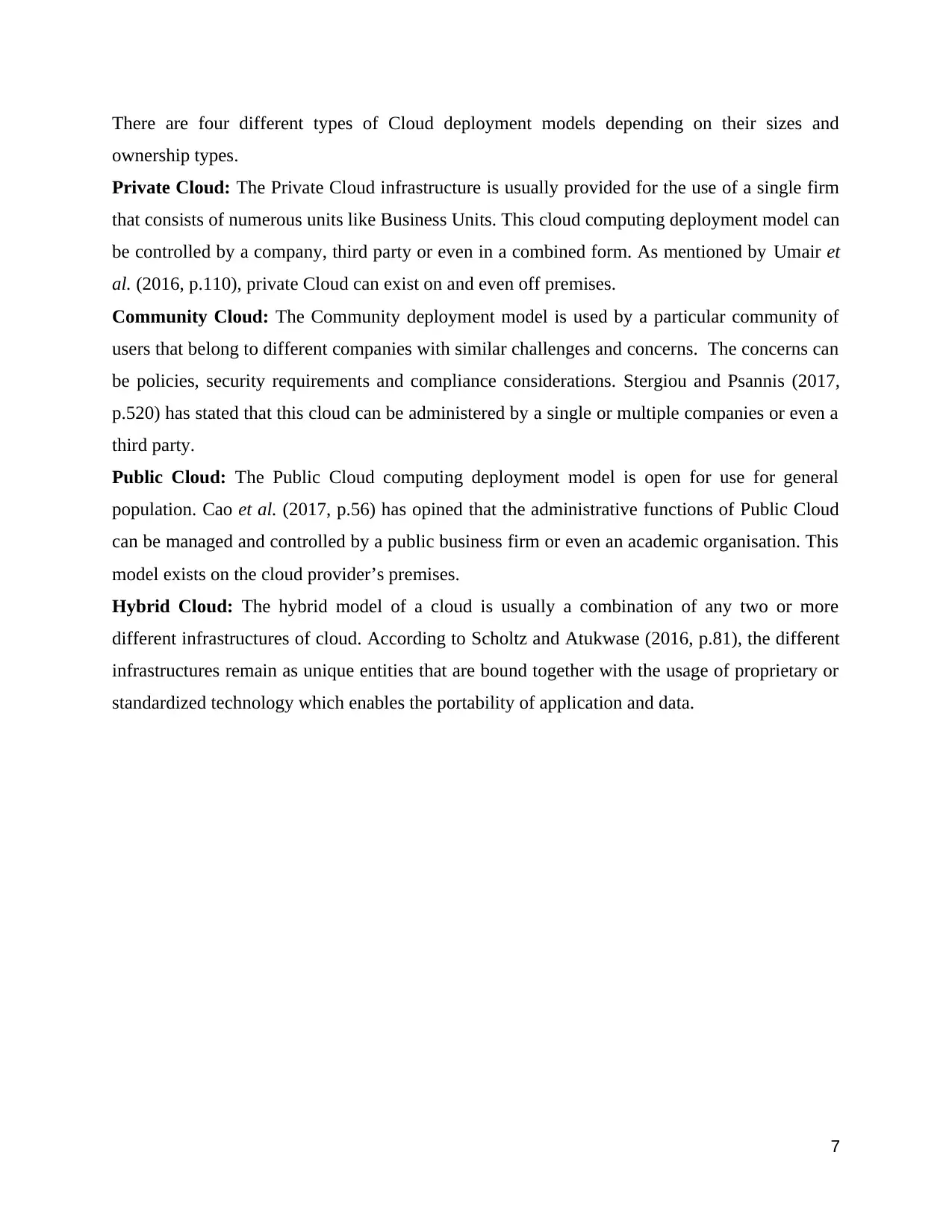
There are four different types of Cloud deployment models depending on their sizes and
ownership types.
Private Cloud: The Private Cloud infrastructure is usually provided for the use of a single firm
that consists of numerous units like Business Units. This cloud computing deployment model can
be controlled by a company, third party or even in a combined form. As mentioned by Umair et
al. (2016, p.110), private Cloud can exist on and even off premises.
Community Cloud: The Community deployment model is used by a particular community of
users that belong to different companies with similar challenges and concerns. The concerns can
be policies, security requirements and compliance considerations. Stergiou and Psannis (2017,
p.520) has stated that this cloud can be administered by a single or multiple companies or even a
third party.
Public Cloud: The Public Cloud computing deployment model is open for use for general
population. Cao et al. (2017, p.56) has opined that the administrative functions of Public Cloud
can be managed and controlled by a public business firm or even an academic organisation. This
model exists on the cloud provider’s premises.
Hybrid Cloud: The hybrid model of a cloud is usually a combination of any two or more
different infrastructures of cloud. According to Scholtz and Atukwase (2016, p.81), the different
infrastructures remain as unique entities that are bound together with the usage of proprietary or
standardized technology which enables the portability of application and data.
7
ownership types.
Private Cloud: The Private Cloud infrastructure is usually provided for the use of a single firm
that consists of numerous units like Business Units. This cloud computing deployment model can
be controlled by a company, third party or even in a combined form. As mentioned by Umair et
al. (2016, p.110), private Cloud can exist on and even off premises.
Community Cloud: The Community deployment model is used by a particular community of
users that belong to different companies with similar challenges and concerns. The concerns can
be policies, security requirements and compliance considerations. Stergiou and Psannis (2017,
p.520) has stated that this cloud can be administered by a single or multiple companies or even a
third party.
Public Cloud: The Public Cloud computing deployment model is open for use for general
population. Cao et al. (2017, p.56) has opined that the administrative functions of Public Cloud
can be managed and controlled by a public business firm or even an academic organisation. This
model exists on the cloud provider’s premises.
Hybrid Cloud: The hybrid model of a cloud is usually a combination of any two or more
different infrastructures of cloud. According to Scholtz and Atukwase (2016, p.81), the different
infrastructures remain as unique entities that are bound together with the usage of proprietary or
standardized technology which enables the portability of application and data.
7
Paraphrase This Document
Need a fresh take? Get an instant paraphrase of this document with our AI Paraphraser
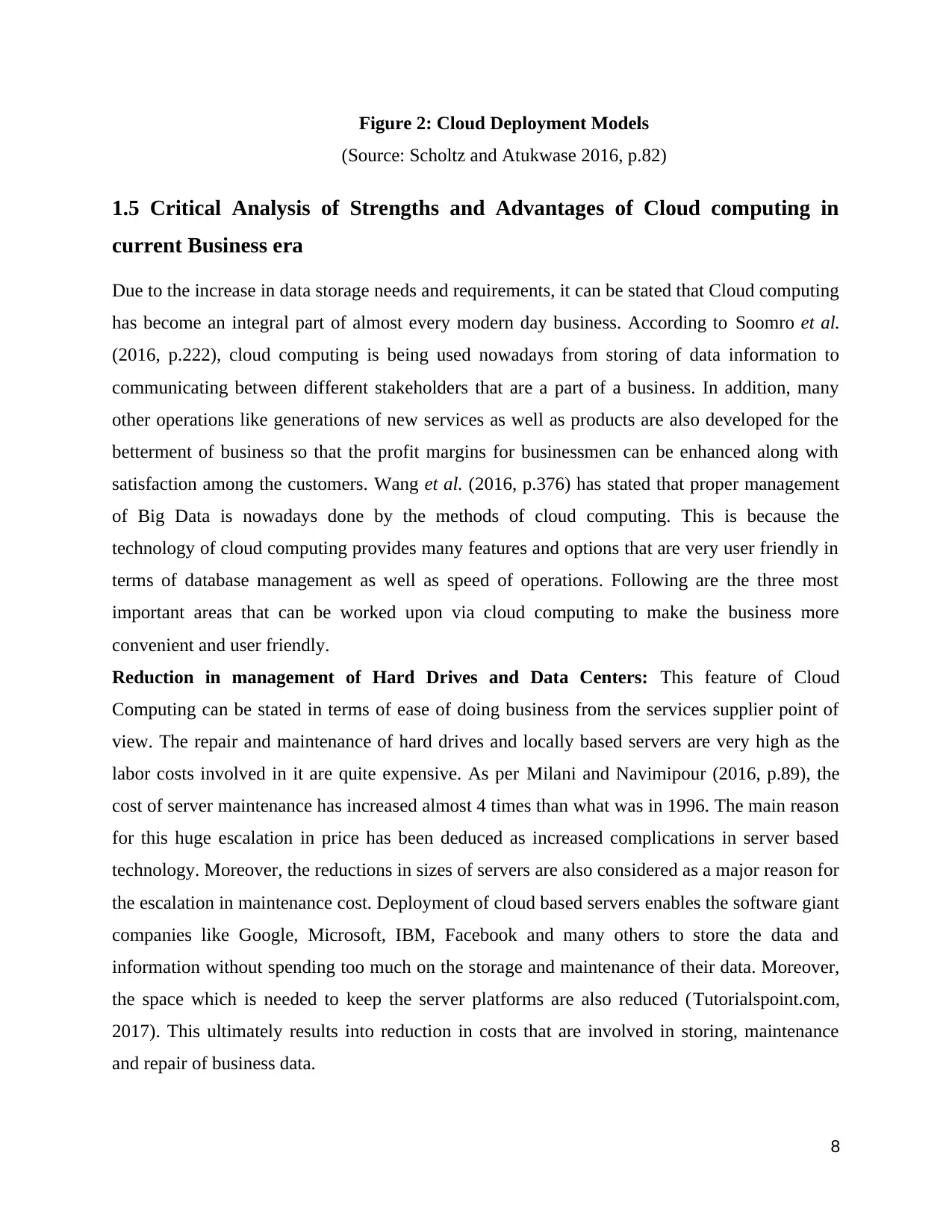
Figure 2: Cloud Deployment Models
(Source: Scholtz and Atukwase 2016, p.82)
1.5 Critical Analysis of Strengths and Advantages of Cloud computing in
current Business era
Due to the increase in data storage needs and requirements, it can be stated that Cloud computing
has become an integral part of almost every modern day business. According to Soomro et al.
(2016, p.222), cloud computing is being used nowadays from storing of data information to
communicating between different stakeholders that are a part of a business. In addition, many
other operations like generations of new services as well as products are also developed for the
betterment of business so that the profit margins for businessmen can be enhanced along with
satisfaction among the customers. Wang et al. (2016, p.376) has stated that proper management
of Big Data is nowadays done by the methods of cloud computing. This is because the
technology of cloud computing provides many features and options that are very user friendly in
terms of database management as well as speed of operations. Following are the three most
important areas that can be worked upon via cloud computing to make the business more
convenient and user friendly.
Reduction in management of Hard Drives and Data Centers: This feature of Cloud
Computing can be stated in terms of ease of doing business from the services supplier point of
view. The repair and maintenance of hard drives and locally based servers are very high as the
labor costs involved in it are quite expensive. As per Milani and Navimipour (2016, p.89), the
cost of server maintenance has increased almost 4 times than what was in 1996. The main reason
for this huge escalation in price has been deduced as increased complications in server based
technology. Moreover, the reductions in sizes of servers are also considered as a major reason for
the escalation in maintenance cost. Deployment of cloud based servers enables the software giant
companies like Google, Microsoft, IBM, Facebook and many others to store the data and
information without spending too much on the storage and maintenance of their data. Moreover,
the space which is needed to keep the server platforms are also reduced (Tutorialspoint.com,
2017). This ultimately results into reduction in costs that are involved in storing, maintenance
and repair of business data.
8
(Source: Scholtz and Atukwase 2016, p.82)
1.5 Critical Analysis of Strengths and Advantages of Cloud computing in
current Business era
Due to the increase in data storage needs and requirements, it can be stated that Cloud computing
has become an integral part of almost every modern day business. According to Soomro et al.
(2016, p.222), cloud computing is being used nowadays from storing of data information to
communicating between different stakeholders that are a part of a business. In addition, many
other operations like generations of new services as well as products are also developed for the
betterment of business so that the profit margins for businessmen can be enhanced along with
satisfaction among the customers. Wang et al. (2016, p.376) has stated that proper management
of Big Data is nowadays done by the methods of cloud computing. This is because the
technology of cloud computing provides many features and options that are very user friendly in
terms of database management as well as speed of operations. Following are the three most
important areas that can be worked upon via cloud computing to make the business more
convenient and user friendly.
Reduction in management of Hard Drives and Data Centers: This feature of Cloud
Computing can be stated in terms of ease of doing business from the services supplier point of
view. The repair and maintenance of hard drives and locally based servers are very high as the
labor costs involved in it are quite expensive. As per Milani and Navimipour (2016, p.89), the
cost of server maintenance has increased almost 4 times than what was in 1996. The main reason
for this huge escalation in price has been deduced as increased complications in server based
technology. Moreover, the reductions in sizes of servers are also considered as a major reason for
the escalation in maintenance cost. Deployment of cloud based servers enables the software giant
companies like Google, Microsoft, IBM, Facebook and many others to store the data and
information without spending too much on the storage and maintenance of their data. Moreover,
the space which is needed to keep the server platforms are also reduced (Tutorialspoint.com,
2017). This ultimately results into reduction in costs that are involved in storing, maintenance
and repair of business data.
8
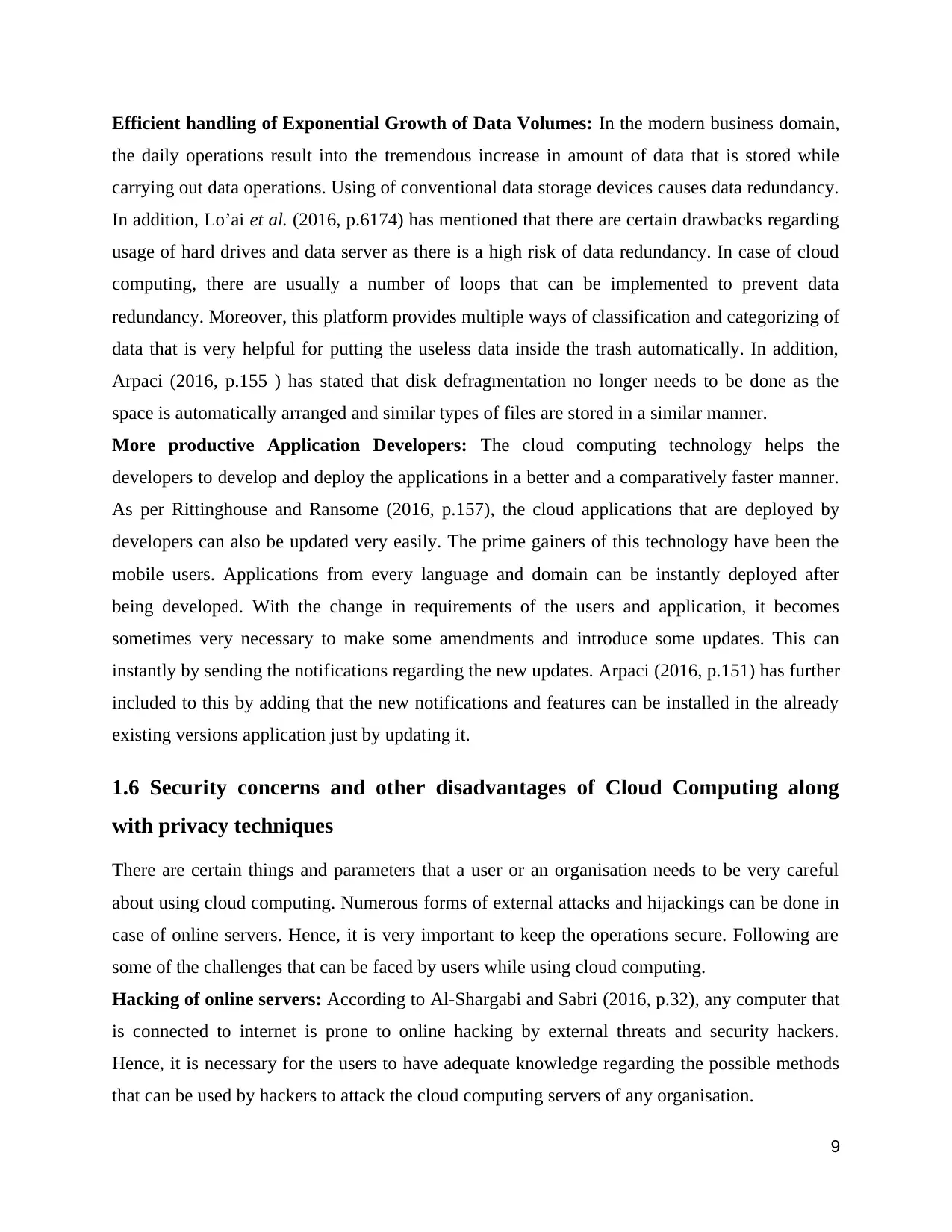
Efficient handling of Exponential Growth of Data Volumes: In the modern business domain,
the daily operations result into the tremendous increase in amount of data that is stored while
carrying out data operations. Using of conventional data storage devices causes data redundancy.
In addition, Lo’ai et al. (2016, p.6174) has mentioned that there are certain drawbacks regarding
usage of hard drives and data server as there is a high risk of data redundancy. In case of cloud
computing, there are usually a number of loops that can be implemented to prevent data
redundancy. Moreover, this platform provides multiple ways of classification and categorizing of
data that is very helpful for putting the useless data inside the trash automatically. In addition,
Arpaci (2016, p.155 ) has stated that disk defragmentation no longer needs to be done as the
space is automatically arranged and similar types of files are stored in a similar manner.
More productive Application Developers: The cloud computing technology helps the
developers to develop and deploy the applications in a better and a comparatively faster manner.
As per Rittinghouse and Ransome (2016, p.157), the cloud applications that are deployed by
developers can also be updated very easily. The prime gainers of this technology have been the
mobile users. Applications from every language and domain can be instantly deployed after
being developed. With the change in requirements of the users and application, it becomes
sometimes very necessary to make some amendments and introduce some updates. This can
instantly by sending the notifications regarding the new updates. Arpaci (2016, p.151) has further
included to this by adding that the new notifications and features can be installed in the already
existing versions application just by updating it.
1.6 Security concerns and other disadvantages of Cloud Computing along
with privacy techniques
There are certain things and parameters that a user or an organisation needs to be very careful
about using cloud computing. Numerous forms of external attacks and hijackings can be done in
case of online servers. Hence, it is very important to keep the operations secure. Following are
some of the challenges that can be faced by users while using cloud computing.
Hacking of online servers: According to Al-Shargabi and Sabri (2016, p.32), any computer that
is connected to internet is prone to online hacking by external threats and security hackers.
Hence, it is necessary for the users to have adequate knowledge regarding the possible methods
that can be used by hackers to attack the cloud computing servers of any organisation.
9
the daily operations result into the tremendous increase in amount of data that is stored while
carrying out data operations. Using of conventional data storage devices causes data redundancy.
In addition, Lo’ai et al. (2016, p.6174) has mentioned that there are certain drawbacks regarding
usage of hard drives and data server as there is a high risk of data redundancy. In case of cloud
computing, there are usually a number of loops that can be implemented to prevent data
redundancy. Moreover, this platform provides multiple ways of classification and categorizing of
data that is very helpful for putting the useless data inside the trash automatically. In addition,
Arpaci (2016, p.155 ) has stated that disk defragmentation no longer needs to be done as the
space is automatically arranged and similar types of files are stored in a similar manner.
More productive Application Developers: The cloud computing technology helps the
developers to develop and deploy the applications in a better and a comparatively faster manner.
As per Rittinghouse and Ransome (2016, p.157), the cloud applications that are deployed by
developers can also be updated very easily. The prime gainers of this technology have been the
mobile users. Applications from every language and domain can be instantly deployed after
being developed. With the change in requirements of the users and application, it becomes
sometimes very necessary to make some amendments and introduce some updates. This can
instantly by sending the notifications regarding the new updates. Arpaci (2016, p.151) has further
included to this by adding that the new notifications and features can be installed in the already
existing versions application just by updating it.
1.6 Security concerns and other disadvantages of Cloud Computing along
with privacy techniques
There are certain things and parameters that a user or an organisation needs to be very careful
about using cloud computing. Numerous forms of external attacks and hijackings can be done in
case of online servers. Hence, it is very important to keep the operations secure. Following are
some of the challenges that can be faced by users while using cloud computing.
Hacking of online servers: According to Al-Shargabi and Sabri (2016, p.32), any computer that
is connected to internet is prone to online hacking by external threats and security hackers.
Hence, it is necessary for the users to have adequate knowledge regarding the possible methods
that can be used by hackers to attack the cloud computing servers of any organisation.
9
⊘ This is a preview!⊘
Do you want full access?
Subscribe today to unlock all pages.

Trusted by 1+ million students worldwide
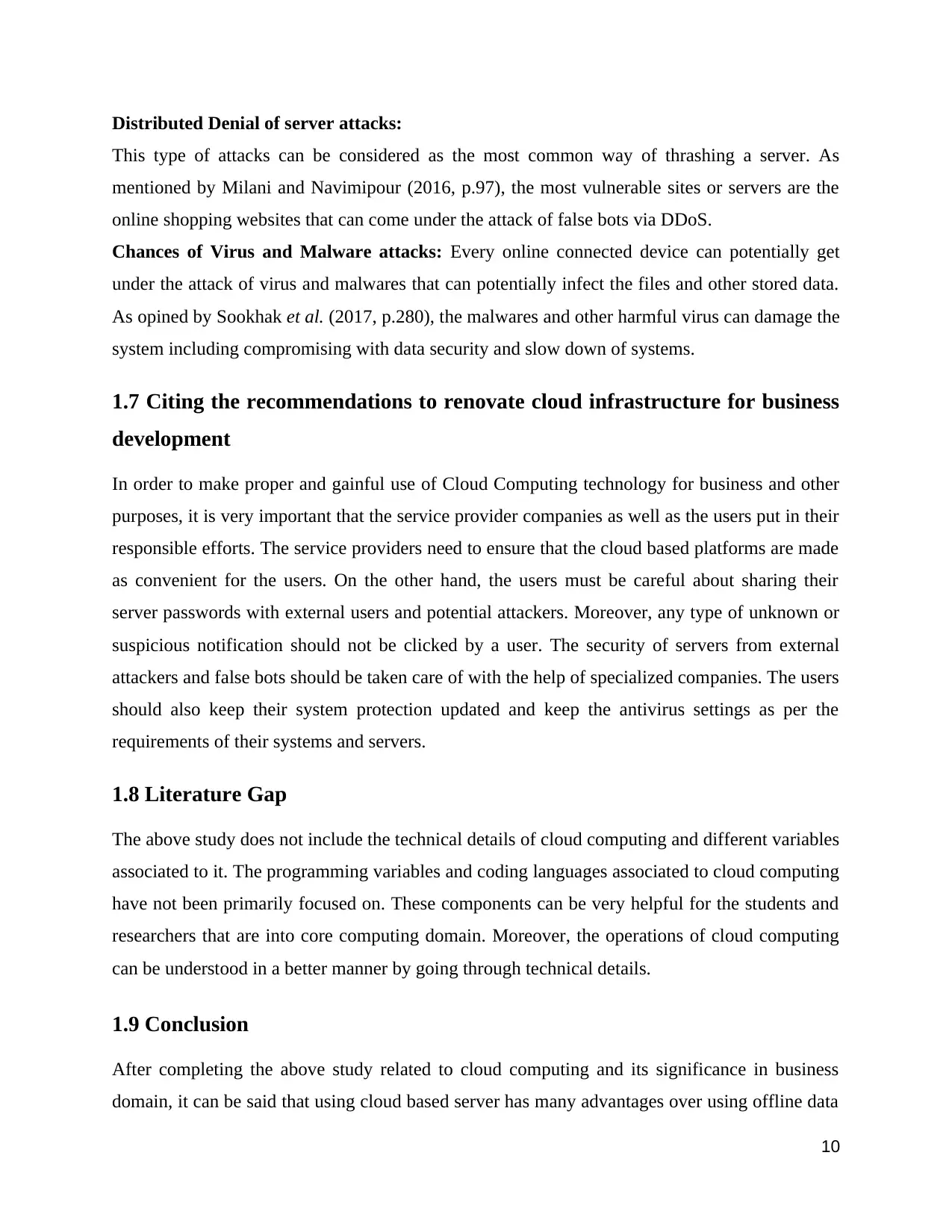
Distributed Denial of server attacks:
This type of attacks can be considered as the most common way of thrashing a server. As
mentioned by Milani and Navimipour (2016, p.97), the most vulnerable sites or servers are the
online shopping websites that can come under the attack of false bots via DDoS.
Chances of Virus and Malware attacks: Every online connected device can potentially get
under the attack of virus and malwares that can potentially infect the files and other stored data.
As opined by Sookhak et al. (2017, p.280), the malwares and other harmful virus can damage the
system including compromising with data security and slow down of systems.
1.7 Citing the recommendations to renovate cloud infrastructure for business
development
In order to make proper and gainful use of Cloud Computing technology for business and other
purposes, it is very important that the service provider companies as well as the users put in their
responsible efforts. The service providers need to ensure that the cloud based platforms are made
as convenient for the users. On the other hand, the users must be careful about sharing their
server passwords with external users and potential attackers. Moreover, any type of unknown or
suspicious notification should not be clicked by a user. The security of servers from external
attackers and false bots should be taken care of with the help of specialized companies. The users
should also keep their system protection updated and keep the antivirus settings as per the
requirements of their systems and servers.
1.8 Literature Gap
The above study does not include the technical details of cloud computing and different variables
associated to it. The programming variables and coding languages associated to cloud computing
have not been primarily focused on. These components can be very helpful for the students and
researchers that are into core computing domain. Moreover, the operations of cloud computing
can be understood in a better manner by going through technical details.
1.9 Conclusion
After completing the above study related to cloud computing and its significance in business
domain, it can be said that using cloud based server has many advantages over using offline data
10
This type of attacks can be considered as the most common way of thrashing a server. As
mentioned by Milani and Navimipour (2016, p.97), the most vulnerable sites or servers are the
online shopping websites that can come under the attack of false bots via DDoS.
Chances of Virus and Malware attacks: Every online connected device can potentially get
under the attack of virus and malwares that can potentially infect the files and other stored data.
As opined by Sookhak et al. (2017, p.280), the malwares and other harmful virus can damage the
system including compromising with data security and slow down of systems.
1.7 Citing the recommendations to renovate cloud infrastructure for business
development
In order to make proper and gainful use of Cloud Computing technology for business and other
purposes, it is very important that the service provider companies as well as the users put in their
responsible efforts. The service providers need to ensure that the cloud based platforms are made
as convenient for the users. On the other hand, the users must be careful about sharing their
server passwords with external users and potential attackers. Moreover, any type of unknown or
suspicious notification should not be clicked by a user. The security of servers from external
attackers and false bots should be taken care of with the help of specialized companies. The users
should also keep their system protection updated and keep the antivirus settings as per the
requirements of their systems and servers.
1.8 Literature Gap
The above study does not include the technical details of cloud computing and different variables
associated to it. The programming variables and coding languages associated to cloud computing
have not been primarily focused on. These components can be very helpful for the students and
researchers that are into core computing domain. Moreover, the operations of cloud computing
can be understood in a better manner by going through technical details.
1.9 Conclusion
After completing the above study related to cloud computing and its significance in business
domain, it can be said that using cloud based server has many advantages over using offline data
10
Paraphrase This Document
Need a fresh take? Get an instant paraphrase of this document with our AI Paraphraser
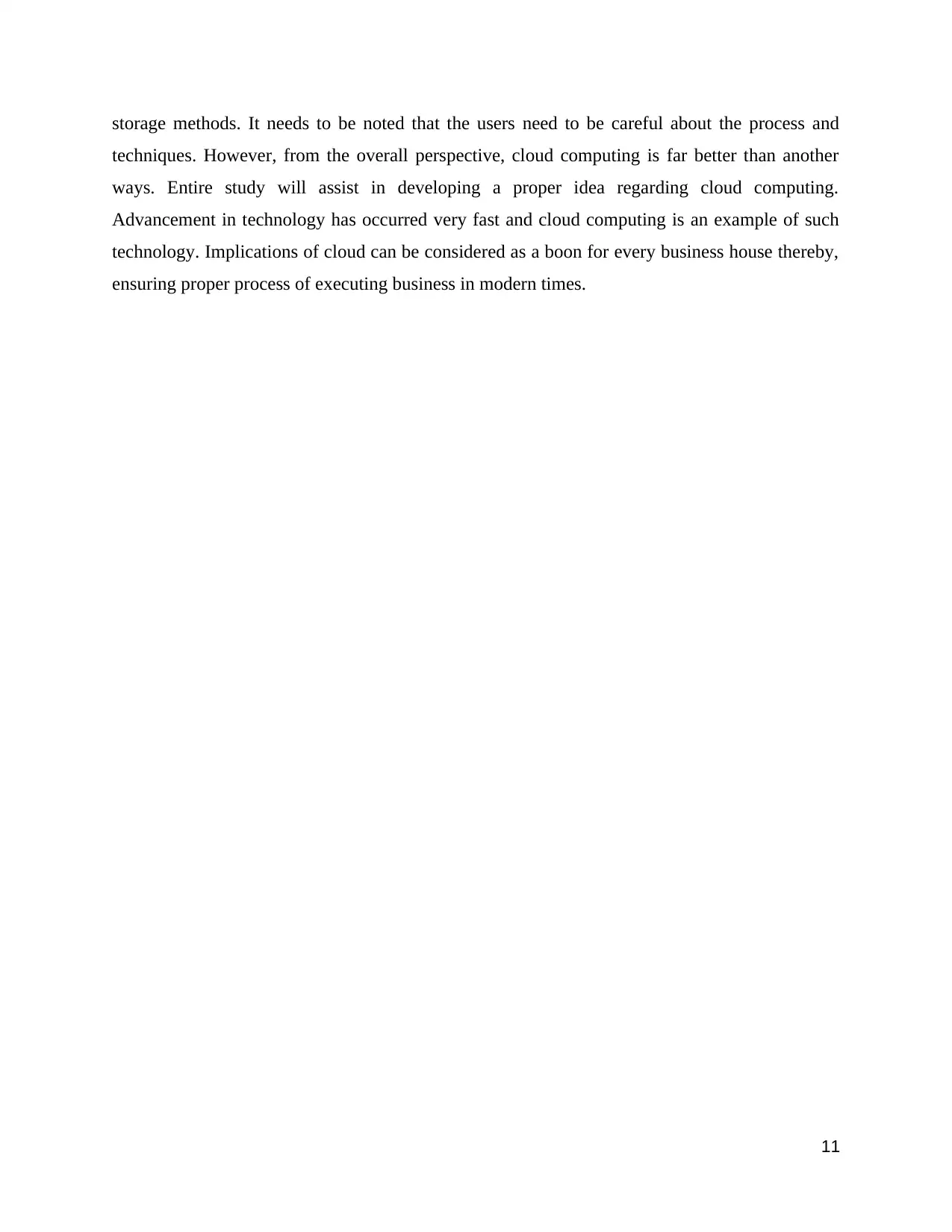
storage methods. It needs to be noted that the users need to be careful about the process and
techniques. However, from the overall perspective, cloud computing is far better than another
ways. Entire study will assist in developing a proper idea regarding cloud computing.
Advancement in technology has occurred very fast and cloud computing is an example of such
technology. Implications of cloud can be considered as a boon for every business house thereby,
ensuring proper process of executing business in modern times.
11
techniques. However, from the overall perspective, cloud computing is far better than another
ways. Entire study will assist in developing a proper idea regarding cloud computing.
Advancement in technology has occurred very fast and cloud computing is an example of such
technology. Implications of cloud can be considered as a boon for every business house thereby,
ensuring proper process of executing business in modern times.
11
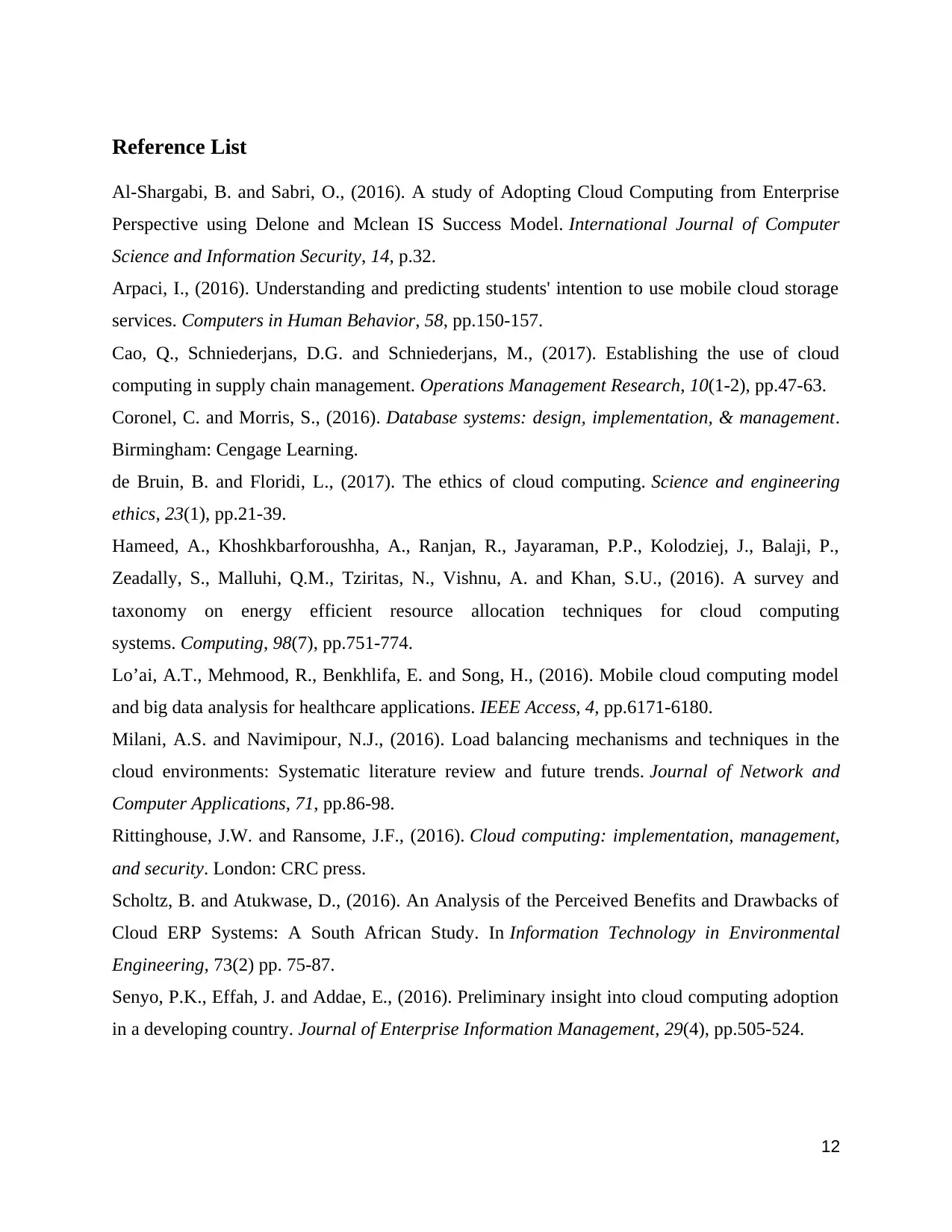
Reference List
Al-Shargabi, B. and Sabri, O., (2016). A study of Adopting Cloud Computing from Enterprise
Perspective using Delone and Mclean IS Success Model. International Journal of Computer
Science and Information Security, 14, p.32.
Arpaci, I., (2016). Understanding and predicting students' intention to use mobile cloud storage
services. Computers in Human Behavior, 58, pp.150-157.
Cao, Q., Schniederjans, D.G. and Schniederjans, M., (2017). Establishing the use of cloud
computing in supply chain management. Operations Management Research, 10(1-2), pp.47-63.
Coronel, C. and Morris, S., (2016). Database systems: design, implementation, & management.
Birmingham: Cengage Learning.
de Bruin, B. and Floridi, L., (2017). The ethics of cloud computing. Science and engineering
ethics, 23(1), pp.21-39.
Hameed, A., Khoshkbarforoushha, A., Ranjan, R., Jayaraman, P.P., Kolodziej, J., Balaji, P.,
Zeadally, S., Malluhi, Q.M., Tziritas, N., Vishnu, A. and Khan, S.U., (2016). A survey and
taxonomy on energy efficient resource allocation techniques for cloud computing
systems. Computing, 98(7), pp.751-774.
Lo’ai, A.T., Mehmood, R., Benkhlifa, E. and Song, H., (2016). Mobile cloud computing model
and big data analysis for healthcare applications. IEEE Access, 4, pp.6171-6180.
Milani, A.S. and Navimipour, N.J., (2016). Load balancing mechanisms and techniques in the
cloud environments: Systematic literature review and future trends. Journal of Network and
Computer Applications, 71, pp.86-98.
Rittinghouse, J.W. and Ransome, J.F., (2016). Cloud computing: implementation, management,
and security. London: CRC press.
Scholtz, B. and Atukwase, D., (2016). An Analysis of the Perceived Benefits and Drawbacks of
Cloud ERP Systems: A South African Study. In Information Technology in Environmental
Engineering, 73(2) pp. 75-87.
Senyo, P.K., Effah, J. and Addae, E., (2016). Preliminary insight into cloud computing adoption
in a developing country. Journal of Enterprise Information Management, 29(4), pp.505-524.
12
Al-Shargabi, B. and Sabri, O., (2016). A study of Adopting Cloud Computing from Enterprise
Perspective using Delone and Mclean IS Success Model. International Journal of Computer
Science and Information Security, 14, p.32.
Arpaci, I., (2016). Understanding and predicting students' intention to use mobile cloud storage
services. Computers in Human Behavior, 58, pp.150-157.
Cao, Q., Schniederjans, D.G. and Schniederjans, M., (2017). Establishing the use of cloud
computing in supply chain management. Operations Management Research, 10(1-2), pp.47-63.
Coronel, C. and Morris, S., (2016). Database systems: design, implementation, & management.
Birmingham: Cengage Learning.
de Bruin, B. and Floridi, L., (2017). The ethics of cloud computing. Science and engineering
ethics, 23(1), pp.21-39.
Hameed, A., Khoshkbarforoushha, A., Ranjan, R., Jayaraman, P.P., Kolodziej, J., Balaji, P.,
Zeadally, S., Malluhi, Q.M., Tziritas, N., Vishnu, A. and Khan, S.U., (2016). A survey and
taxonomy on energy efficient resource allocation techniques for cloud computing
systems. Computing, 98(7), pp.751-774.
Lo’ai, A.T., Mehmood, R., Benkhlifa, E. and Song, H., (2016). Mobile cloud computing model
and big data analysis for healthcare applications. IEEE Access, 4, pp.6171-6180.
Milani, A.S. and Navimipour, N.J., (2016). Load balancing mechanisms and techniques in the
cloud environments: Systematic literature review and future trends. Journal of Network and
Computer Applications, 71, pp.86-98.
Rittinghouse, J.W. and Ransome, J.F., (2016). Cloud computing: implementation, management,
and security. London: CRC press.
Scholtz, B. and Atukwase, D., (2016). An Analysis of the Perceived Benefits and Drawbacks of
Cloud ERP Systems: A South African Study. In Information Technology in Environmental
Engineering, 73(2) pp. 75-87.
Senyo, P.K., Effah, J. and Addae, E., (2016). Preliminary insight into cloud computing adoption
in a developing country. Journal of Enterprise Information Management, 29(4), pp.505-524.
12
⊘ This is a preview!⊘
Do you want full access?
Subscribe today to unlock all pages.

Trusted by 1+ million students worldwide
1 out of 13
Related Documents
Your All-in-One AI-Powered Toolkit for Academic Success.
+13062052269
info@desklib.com
Available 24*7 on WhatsApp / Email
![[object Object]](/_next/static/media/star-bottom.7253800d.svg)
Unlock your academic potential
Copyright © 2020–2025 A2Z Services. All Rights Reserved. Developed and managed by ZUCOL.




